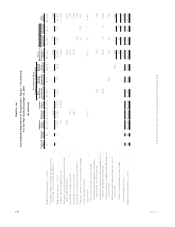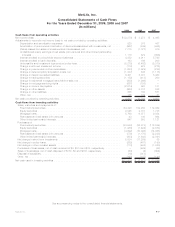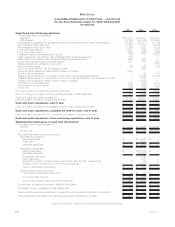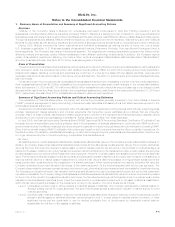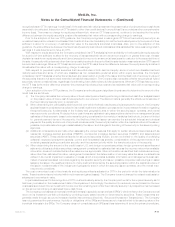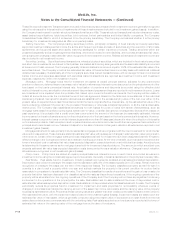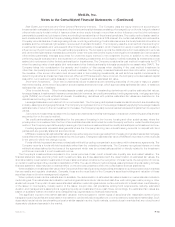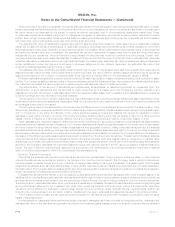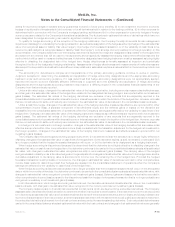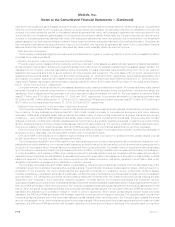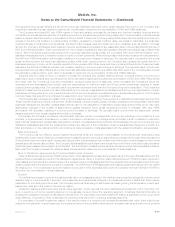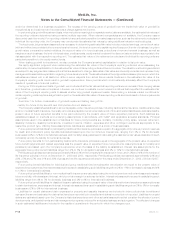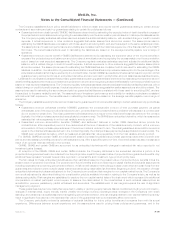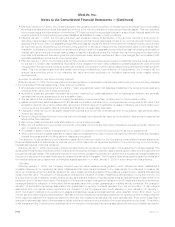MetLife 2009 Annual Report Download - page 98
Download and view the complete annual report
Please find page 98 of the 2009 MetLife annual report below. You can navigate through the pages in the report by either clicking on the pages listed below, or by using the keyword search tool below to find specific information within the annual report.When observable inputs are not available, the market standard valuation methodologies for determining the estimated fair value of certain
types of securities that trade infrequently, and therefore have little or no price transparency, rely on inputs that are significant to the estimated
fair value that are not observable in the market or cannot be derived principally from or corroborated by observable market data. These
unobservable inputs can be based in large part on management judgment or estimation, and cannot be supported by reference to market
activity. Even though unobservable, these inputs are based on assumptions deemed appropriate given the circumstances and consistent
with what other market participants would use when pricing such securities.
The estimated fair value of residential mortgage loans held-for-sale are determined based on observable pricing of residential mortgage
loans held-for-sale with similar characteristics, or observable pricing for securities backed by similar types of loans, adjusted to convert the
securities prices to loan prices. Generally, quoted market prices are not available. When observable pricing for similar loans, or securities that
are backed by similar loans, are not available, the estimated fair values of residential mortgage loans held-for-sale are determined using
independent broker quotations, which is intended to approximate the amounts that would be received from third parties. Certain other
mortgage loans have also been designated as held-for-sale which are recorded at the lower of amortized cost or estimated fair value less
expected disposition costs determined on an individual loan basis. For these loans, estimated fair value is determined using independent
broker quotations or, when the loan is in foreclosure or otherwise determined to be collateral dependent, the estimated fair value of the
underlying collateral estimated using internal models.
The estimated fair value of MSRs is principally determined through the use of internal discounted cash flow models which utilize various
assumptions as to discount rates, loan-prepayments and servicing costs. The use of different valuation assumptions and inputs, as well as
assumptions relating to the collection of expected cash flows may have a material effect on the estimated fair values of MSRs.
Financial markets are susceptible to severe events evidenced by rapid depreciation in asset values accompanied by a reduction in asset
liquidity. The Company’s ability to sell securities, or the price ultimately realized for these securities, depends upon the demand and liquidity in
the market and increases the use of judgment in determining the estimated fair value of certain securities.
The determination of the amount of allowances and impairments, as applicable, is described previously by investment type. The
determination of such allowances and impairments is highly subjective and is based upon the Company’s periodic evaluation and
assessment of known and inherent risks associated with the respective asset class. Such evaluations and assessments are revised as
conditions change and new information becomes available.
The recognition of income on certain investments (e.g. loan-backed securities, including mortgage-backed and asset-backed securities,
certain structured investment transactions, trading securities, etc.) is dependent upon market conditions, which could result in prepayments
and changes in amounts to be earned.
The accounting rules for the determination of when an entity is a VIE and when to consolidate a VIE are complex. The determination of the
VIE’s primary beneficiary requires an evaluation of the contractual and implied rights and obligations associated with each party’s relationship
with or involvement in the entity, an estimate of the entity’s expected losses and expected residual returns and the allocation of such
estimates to each party involved in the entity. The primary beneficiary is defined as the entity that will absorb a majority of a VIE’s expected
losses, receive a majority of a VIE’s expected residual returns if no single entity absorbs a majority of expected losses, or both.
When assessing the expected losses to determine the primary beneficiary for structured investment products such as asset-backed
securitizations and collateralized debt obligations, the Company uses historical default probabilities based on the credit rating of each issuer
and other inputs including maturity dates, industry classifications and geographic location. Using computational algorithms, the analysis
simulates default scenarios resulting in a range of expected losses and the probability associated with each occurrence. For other investment
structures such as hybrid securities, joint ventures, limited partnerships and limited liability companies, the Company takes into consideration
the design of the VIE and generally uses a qualitative approach to determine if it is the primary beneficiary. This approach includes an analysis
of all contractual and implied rights and obligations held by all parties including profit and loss allocations, repayment or residual value
guarantees, put and call options and other derivative instruments. If the primary beneficiary of a VIE can not be identified using this qualitative
approach, the Company calculates the expected losses and expected residual returns of the VIE using a probability-weighted cash flow
model. The use of different methodologies, assumptions and inputs in the determination of the primary beneficiary could have a material
effect on the amounts presented within the consolidated financial statements.
Derivative Financial Instruments
Derivatives are financial instruments whose values are derived from interest rates, foreign currency exchange rates, or other financial
indices. Derivatives may be exchange-traded or contracted in the over-the-counter market. The Company uses a variety of derivatives,
including swaps, forwards, futures and option contracts, to manage risks relating to its ongoing business. To a lesser extent, the Company
uses credit derivatives, such as credit default swaps, to synthetically replicate investment risks and returns which are not readily available in
the cash market. The Company also purchases certain securities, issues certain insurance policies and investment contracts and engages in
certain reinsurance contracts that have embedded derivatives.
Freestanding derivatives are carried on the Company’s consolidated balance sheets either as assets within other invested assets or as
liabilities within other liabilities at estimated fair value as determined through the use of quoted market prices for exchange-traded derivatives
and interest rate forwards to sell certain to-be-announced securities or through the use of pricing models for over-the-counter derivatives.
The determination of estimated fair value, when quoted market values are not available, is based on market standard valuation methodologies
and inputs that are assumed to be consistent with what other market participants would use when pricing the instruments. Derivative
valuations can be affected by changes in interest rates, foreign currency exchange rates, financial indices, credit spreads, default risk
(including the counterparties to the contract), volatility, liquidity and changes in estimates and assumptions used in the pricing models.
The Company does not offset the fair value amounts recognized for derivatives executed with the same counterparty under the same
master netting agreement.
If a derivative is not designated as an accounting hedge or its use in managing risk does not qualify for hedge accounting, changes in the
estimated fair value of the derivative are generally reported in net investment gains (losses) except for those (i) in policyholder benefits and
F-14 MetLife, Inc.
MetLife, Inc.
Notes to the Consolidated Financial Statements — (Continued)




